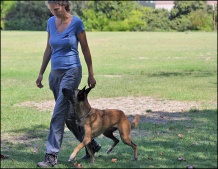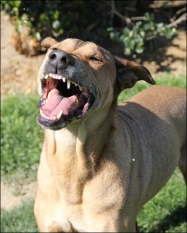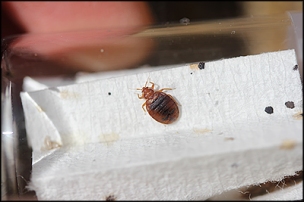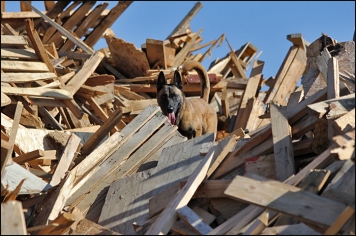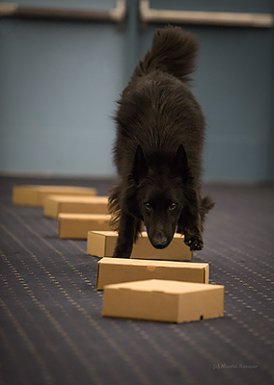- Have a Goal
Don’t train a whole routine all at once if you still have kinks to work out. Go into training with a clear, identifiable goal. Work specifics like leash handling, speed, alert, converging odors or that perfect heel. Be clear what your expectations are, even write them down. Have a realistic outcome in mind.
- Have a Gameplan
Once you know, what exactly you want to work on, have a plan on how to achieve your set goal. Don’t go on the field or in your search area just ‘winging it’ – that will lead to frustration and is not very effective. Don’t hesitate to deviate from your start plan though, if you see a new (or old) issue arise. For example, if your goal is to work on your leash handling and your dog all of a sudden shows issues with distractions, change plan. Concentrate on one issue, don’t try to tackle two or three problems in the same training run – most of the time, that is not only less effective, it can also create a whole other set of issues. - Tailor the length of training to your dog’s abilities
This should hardly come as a surprise, but we often tend to forget and train longer than we should, because we ‘set aside this amount of time’ or we ‘paid for an hour with a trainer’. But training is can be more effective when we cut it short, depending on the circumstance. A puppy or young dog has a different attention span than an adult dog. A dog, who recently was sick or injured may also not be able to concentrate as long as a healthy dog. Hot weather might call for a shorter training and so does a new environment, if your dog is easily distracted. Know your dog and know your dog’s attention span. - Stop while you are still having fun and don’t train, when you’re emotional
This ties into the above issue. Don’t train until you don’t have your dog’s attention anymore. If you have to ask yourself: ‘Should I do one more?’ – the answer is ‘No!’ more often than not. End on a high note. Don’t get frustrated. If you don’t feel up for training, if you’re angry at something or someone, if you are already frustrated – don’t start training. Instead relax and play or just cuddle with your dog. Pick up training when you feel calm. This doesn’t only lead to a more reliable and stable dog, but it also improves your bond and keeps the trust between the two of you.
- Take care of your training aids
Your training aids are important. Leashes, collars, toys, food, odor/scent articles, whatever you need for your training, needs to be in tip top shape. The best game plan won’t help you, if your training odor is off or you have the wrong reward toy/food. This is especially important for scent detection training. Know what you are training with, know your aids and know your tools. - Maintain a training log
A training log can help you identify issues, help troubleshoot and solving those issues and re-create training scenarios. It can also help in developing a good strategy for your next training. It is your ‘black-on-white’ memory. - Variety is your friend
Once your dog shows you the behavior you are asking for, change the environment. Change the reward. Change the odor amount, if you are doing scent detection. You never know, what you will encounter at a trial, competition or work place. Train with distractions, outside, inside, day time, night time, shiny floors, dark corners, spectators. Change the containers you use to keep the odor for your scent detection. Use different leashes. Vary the amount of food for reward or time you play with your dog. Use your training log to record the environment you trained in.
- Wear proper training attire
Closed-toed shoes are a must, unless you don’t mind your dog pushing himself off on your bare foot, leaving behind painful scratches and bruises. Make sure, you have everything on you that is needed for your training, such as reward and leash. Be prepared and have a first aid kit nearby. - Give your dog a break
Dogs need breaks to process what they learned. There are numerous studies, not only on rats and humans, but also on dogs, showing, that given some downtime, the individuals outperformed others, who did not get a break. Additional to the increase in performance, downtime provides opportunity for a quick canine first aid check (temperature, scratches, etc.) and hydration. - The Power of Videotaping your training
When you are working your dog, there are lots of things going through your mind. Leash handling, environment, controlling/not controlling your dog, anticipating… Nuances and subtleties are quickly overlooked – yet that’s what makes us progress. If you have video of your training, you can sit back after working (give your dog a break) and study each aspect of the run. How did you move that leash? What was your body language telling the dog? What was the dog’s behavior telling you? We all get set in repetition and with repetitions come handler errors. The dog alerts away from source, because you don’t reward at source. The dog anticipates a recall because of your leg movement. Nothing will show your mistakes as honestly as a video.
There is a number 11, a simple step, which is so often overlooked: use common sense. If your gut tells you, that something doesn’t feel right, stop, take a step back and think. Don’t hesitate to ask questions. A responsible trainer will discuss your feelings with you and make necessary changes to the training plan.

